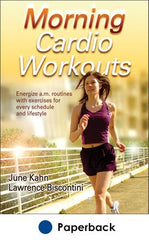Jogging offers same health benefits as walking
This is an excerpt from Morning Cardio Workouts by June Kahn & Lawrence Biscontini.
Jogging is the next natural step from walking. Jogging is a form of trotting or running at a slow or leisurely pace with the main intention to increase fitness, endurance, and caloric expenditure. Jogging, like walking, can be done anytime, anywhere, and can be done alone or in a group. Jogging has all the health benefits of walking: It conditions the heart, improves muscle tone and strength, relieves stress, and can help with a variety of health problems including heart disease and arthritis. However, whereas walking is a low-impact activity because one foot is always in contact with the ground, in jogging and in running, impact is introduced. This is a high-impact exercise that places strain on the body, notably the joints of the knee. But impact can actually be a good thing. Because jogging is a weight-bearing activity, it will enhance bone density, which can reduce the risk of osteoporosis.
The big advantage of jogging over walking is that you can cover the same distance in a shorter period of time. The disadvantage is that it can result in more injuries than walking, because the strain placed on both muscles and joints is greater. But with proper shoes and preparation through stretching, you can greatly reduce your risk of injury.
Jogging and running, like walking, involve rhythmic, forward action of the legs that target the large lower muscles of the body including the hip flexors, gluteus maximus, quadriceps, and hamstrings. Assisting those muscles are the gastrocnemius and the anterior tibialis. The less obvious, yet equally important, muscles are your hip abductors and hip adductors, which are responsible for stabilizing the hips and legs in general. The torso muscles are also actively engaged to keep your torso erect as your arms swing naturally with your stride. Because of the level of impact associated with both jogging and running, proper alignment of the torso is paramount in limiting stress to the joints and low back. Visualize and create a tall vertical position of your torso, keeping your abdominal muscles engaged throughout your jog. Maintain a strong upper postural position by keeping your shoulders down, creating lots of distance between your shoulders and ears to avoid carrying your arms too high.
While jogging, you should leap, transferring your weight evenly and softly from one foot to the next. You should avoid leaping too high into the air, however, and landing heavily on your heel. Such form wastes energy and exacerbates the impact of the exercise. Create a normal foot strike that lands flat on the outer back portion of the heel, rolls onto the sole, and ends with the push-off from the ball of the foot. A heavy heel strike can lead to excessive traumatic forces and actually slow you down. Landing on the midfoot or ball of the foot places more stress on the Achilles tendon (which contracts to counterbalance the force of the strike).
A well-fitted running shoe is the most basic requirement for jogging. You will need to try on a variety of models to see which style provides the best overall fit. The amount of cushioning you require depends on how hard your foot strikes the ground during your stride. The frame and build of your body will help you determine how much cushioning you need. A small-framed person does not create a severe impact with the ground in comparison to a large-framed person, and so would require less overall cushioning. Because the greatest loads are at the heel and ball of the foot (as much as three times your body weight), choose a shoe that provides the most cushioning in both areas. The heel cup of the shoe should be stable and offer lateral (side-to-side) support as your heel contacts the ground. As you jog, your toes bend and extend as you push off through your stride. Running shoes need to be flexible enough in the forefoot to allow this to happen. The jogging motion also causes the foot and toes to spread, so allow for ample room in the toe box. Most experts agree that a good pair of comfortable sneakers will suffice; however, as we recommended in walking, choosing a well constructed performance running shoe is a good idea because it is designed specifically for running and will help you avoid injury. If you take the time to choose proper footwear, your feet will not only perform better, they'll feel better too!
All in all, jogging is an efficient and effective way to maintain or enhance your level of cardiovascular fitness. It is also the perfect preparation for running, the next intensity level of high-impact activity for your morning cardio workout.
Read more from Morning Cardio Workouts by June Kahn and Lawrence Biscontini.
More Excerpts From Morning Cardio Workouts

Get the latest insights with regular newsletters, plus periodic product information and special insider offers.
JOIN NOW


